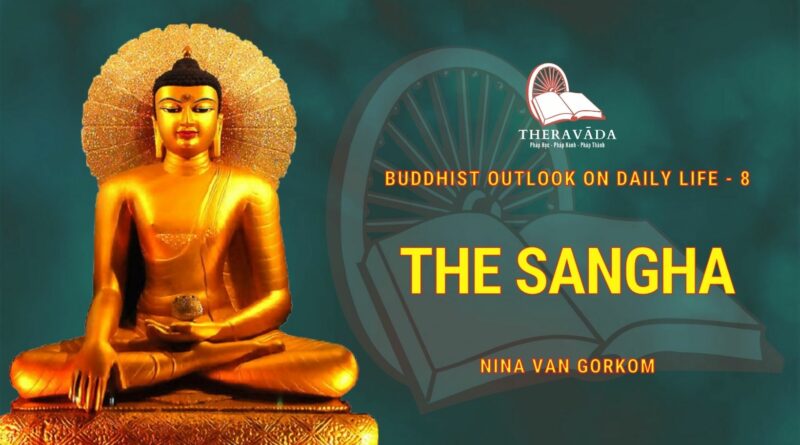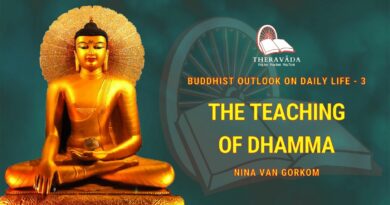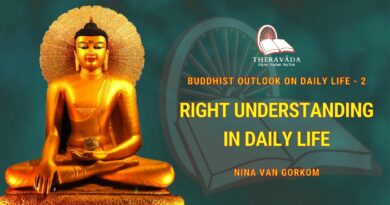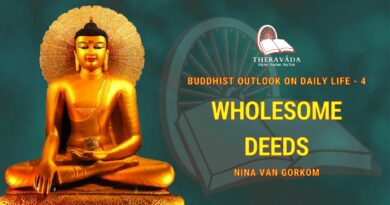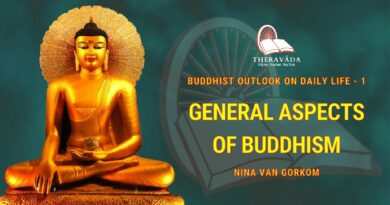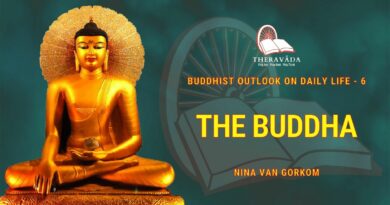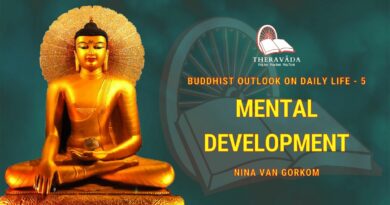BUDDHIST OUTLOOK ON DAILY LIFE – 8. THE SANGHA
The Sangha is the third of the ‘Three Gems’. When Buddhists take their refuge in the Sangha they say: ‘Sangham saranam gacchami’, which means, ‘I go for refuge to the Sangha’, The word sangha literally means ‘congregation’ or ‘community’. It is the word generally used for the order of monks. When the word sangha denotes the third Gem it has a different meaning. The Sangha which is the third Gem are the ariyans. ‘Ariyan‘ is the name which denotes all those who have attained one of the four stages of enlightenment, no matter whether they are monks, nuns (bhikkhuni), unmarried layfollowers or married layfollowers. In the suttas we read that countless men and women layfollowers, single and married, became enlightened (Maha-Vacchgotta-sutta, Majjhima Nikaya II).
In order to understand what enlightenment is, we should first know more about the accumulation of defilements. Defilements are all the imperfections we have accumulated in each citta. Our life is a continuous series of cittas succeeding one another, and thus the process of accumulation is continued from one citta to the next citta, going on from birth to death, and from one life to the next life. One may wonder how a citta can contain all the accumulations of the past. This is possible, because a citta is mentality. Matter which is limited, such as a room, can only contain as much as its space allows. A citta is different from matter, it is unlimited in what it can contain.
The defilements which have accumulated in our citta are very deeply rooted, and can only be eradicated in stages, which are the different stages of enlightenment. First the latent tendency of the concept of self has to be eradicated. We can eradicate the belief in a self in understanding what it is we take for self: in developing vipassana. What we call ‘my body’ are only physical phenomena which arise and fall away and which we cannot control. We read in the ‘Samyutta Nikaya’ (Khandha-vagga, Middle Fifty, par. 59, The Five) that the Buddha said to his first five disciples in the Deerpark of Varanasi:
‘Body, monks, is not the self. If body, monks, were the self, then body would not be involved in sickness, and one could say of body: “Thus let my body be. Thus let my body not be.”‘
The same is said about mentality. The wrong view of self we have accumulated all through our many lives can be eliminated only very gradually. The wisdom will be keener at each stage of vipassana. When one has experienced nibbana for the first time the wrong view of self is eradicated completely and there is no more doubt about realities.
This first stage of enlightenment is the stage of the ‘stream-winner’, in Pali, ‘sotapanna‘. We read in the ‘Samyutta Nikaya’ (Khanda-vagga, Chapter XXV, Kindred Sayings on Entering, par. 1) that the Buddha said to the monks:
‘The eye, monks is impermanent, changeable, becoming otherwise. The ear, monk, is impermanent, changeable. So is the nose, the tongue, the body, and the mind. It is impermanent, changeable, becoming otherwise….
He, monks, who thus knows, thus sees these doctrines, is called “streamwinner, saved from destruction, assures, bound for enlightenment”.’
The sotapanna is sure to attain the last stage of enlightenment, which is the stage of the arahat. The sotapanna has not eradicated all defilements yet; there is still lobha, dosa and moha. He realizes that he still has akusala cittas; he knows that there are still conditions for them, but he does not take them for self. The sotapanna still has defilements, but he will never break the five precepts; it has become his nature to observe them. He cannot commit a deed which can cause rebirth in one of the woeful planes. Those who are not ariyans cannot be sure that they will not be reborn in a woeful plane of existence, even if they have done many good deeds in this life. One may have committed an ill deed in a past life which may cause rebirth in hell. Only ariyans can be sure that they will not reborn in a woeful plane.
The sotapanna has an unshakable confidence in the ‘Three Gems’: in the Buddha, The Dhamma and the Sangha. He has no doubts about the Path the Buddha taught; he cannot delude himself about the right practice of vipassana. If we have not attained enlightenment we can be deluded about the right practice. Instead of developing wisdom we cling to a self, we want to induce awareness, and we cling to results we are hoping for. The sotapanna, however, is firmly established on the Path to the last stage of enlightenment.
The fact that the sotapanna has experienced nibbana does not mean that he cannot continue all his daily activities. The sotapanna can live with husband or wife and have a family life. So too until the third stage of enlightenment, the stage of the ‘non-returner’ or ‘anagami‘. The arahat, however, no longer has any wish for the layman ‘s life.
The sotapanna does not take any nama or rupa for self, but there is still attachment, aversion and ignorance; he still has conceit. Therefore he has to continue the development of vipassana. We read in the ‘Samyutta Nikaya’ (Khandha-vagga, Last Fifty, par. 122, Virtue) that Maha-Kotthita asked Sariputta what would be the object of awareness for a virtuous monk (who has not realized any stage of enlightenment yet), or for a sotapanna, or for those who have realized the subsequent stages of enlightenment. Sariputta explained that the object is the five khandhas of grasping, which are all the namas and rupas in and around oneself. Sariputta said:
‘The five khandhas of grasping, friend Kotthita, are the conditions which should be pondered with method by a virtuous monk, as being impermanent, suffering, sick, as a boil, as a dart, as pain, as ill-health, as alien, as transitory, empty and not self…
Indeed, friend, it is possible for a virtuous monk so pondering with method these five khandhas of grasping to realize the fruits of stream-winning.’
‘But, friend Sariputta, what are the things which should be pondered with method by a monk who is a sotapanna?’
‘By a monk who is a sotapanna, friend Kotthita, it is these same five khandhas of grasping which should be so pondered.
Indeed, friend, it is possible for a monk who is a sotapanna … by so pondering these five khandhas … to realize the fruits of once-returning.’
‘But, friend Sariputta, what are the things which should be pondered with method by a monk who is a sakadagami (once-returner)?’
‘By one who is a sakadagami, friend, it is these same five khandhas which should be pondered with method.
Indeed it is possible, friend, for one who is a sakadagami by so pondering to realize the fruits of non-returning.’
‘But, friend Sariputta, what are the things which should be pondered with method by one who is an anagami (non-returner)?’
‘By such a one, friend Kotthita, it is these five khandhas of grasping which should be so pondered. It is possible, friend, for an anagami by so pondering to realize the fruits of arahatship’.
‘But, what, friend Sariputta, are the things which should be pondered with method by one who is an arahat?’
‘By an arahat, friend Kotthita, these five khandhas should be pondered with method as being impermanent, suffering, sick, as a boil, as a dart, as ill-health, as alien, transitory, void and not self.
For the arahat, there is nothing further to be done, nor is there return to upheaping of what is done. Nevertheless, these things, if practised and enlarged, conduce to a happy existence to self-possession even in this present life.’
The ariyan of the second stage, the sakadagami (once-returner), has not eradicated all attachment and aversion, but they have become attenuated. He still has ignorance, which is only completely eradicated by the arahat. The ariyan of the third stage, the anagami (non-returner), has eradicated aversion and he has eradicated attachment to the things experienced through the five senses, but he still clings to life and he still has conceit.
Ariyans who are not yet arahats can still have conceit, although they have no wrong view of self. They may be inclined to compare themselves with others. When somebody thinks himself better than, equal to or less than someone else, it is conceit, even if it is true. Why should we compare ourselves with others? In the ‘Khemaka-sutta’ (Samyutta Nikaya, Khandha-vagga, Middle Fifty, part 4, par. 89) we read that the monk Khemaka, who was staying in Jujube Tree Park, was afflicted by sickness. Some other monks who were staying near Kosambi in Ghosita Park, asked the monk Dasaka to inquire after his health. After he gave the message that his health was not improving, the other monks told Dasaka to ask Khemaka whether he still took anything for self. When Khemaka had told Dasaka that he did not take anything for self, the other monks concluded that Khemaka must be an arahat. Khemaka answered to Dasaka:
‘Though, friend, I discern in the five khandhas of grasping no self nr anything pertaining to the self, yet am I not arahat, nor one in whom the asavas are destroyed. Though, friend, I see that I have got the idea of “I am” in the five khandhas of grasping, yet do I not discern that I am this “I am”.’
Then the venerable Dasaka returned to the monks with that message and reported the words of the venerable Khemaka (and those monks sent this further message):
‘As to this “I am” friend Khemaka, of which you speak, what do you mean by this “I am”? Do you speak of “I am” as body or as distinct from body? … as consciousness, or as distinct from consciousness? As to this “I am”, what do you mean by it?’ (So the venerable Dasaka went again and took the message in these words:)
‘Enough, friend Dasaka. What boots this running to and fro! Fetch my staff. I will go myself to these monks.’
So the venerable Khemaka, leaning on his staff, came to those monks. When he got there, he greeted them, and exchanging the courtesies of civil words, sat down at one side. As the thus sat, the elders thus spoke to the venerable Khemaka:-
As to this “I am”, friend Khemaka, of which you speak, what do you mean by it? Do you speak of it as body or as distinct from body… as consciousness, or as distinct from consciousness?’
‘No friends, I do not say “I am body” or feeling, or perception, or the activities or consciousness, or as distinct from these and from consciousness. Though, friends, I see that I have got the idea of “I am” in the five khandhas of grasping, yet I do not discern that I am this “I am”. Just as, friends, in the case of the scent of a blue lotus, or a white lotus, -if one should say: “the scent belongs to the petals or the colour or the fibers of it”, would he be rightly describing the scent?’
‘Surely not, friend.’
‘Then how would he be right in describing it?’
‘Surely, friend, by speaking of the scent of the flower.’
‘Even so, friends, I do not speak of the “I am” as a body, or as feeling and so forth. Nevertheless I see that in these five khandhas of grasping I have got the idea of “I am”; yet I do not discern that I am this “I am”. Though, friends, an ariyan disciple has put away the five lower fetters, yet there remains in him a subtle remnant from among the five khandhas of grasping, a subtle remnant of the I-conceit, of the I am-desire, of the lurking tendency to think “I am”, still not removed from him. Later on he lives contemplating the rise and fall of the five khandhas of grasping …
‘In this way, as he lives in the contemplation of the five khandhas of grasping, that subtle remnant of the I am conceit, of the I am-desire, that lurking tendency to think “I am”, which was still not removed from him- that is now removed. Suppose, friends, there is a dirty, soiled cloth, and the owners give it to a Washerman, and he rubs is smooth with salt-earth, or lye or cowdung, and rinses it in pure clean water. Now, though that cloth be clean, utterly cleansed, yet there hangs about it, still unremoved, the smell of the salt-earth or lye or cowdung. The washerman returns it to the owners, and they lay it up in a sweet-scented coffer. Thus that smell … is now utterly removed…’
Further on we read:
Now when this teaching was thus expounded the hearts of as many as sixty monks were utterly set free from the asavas, and so was it also with the heart of the venerable Khemaka.
The arahat has eradicated all defilements and latent tendencies of defilements. He will not be reborn when his life is terminated.
How can we find out who is an ariyan? There is no way to know who is an ariyan, unless we have become enlightened ourselves. It cannot be known from someone’s outward appearance whether he is an ariyan or not. People who are very amiable and peaceful are not necessarily ariyans. However, we can take our refuge in the ariyan Sangha even if we do not personally know any ariyans. We can think of their virtues, no matter whether they are in this plane of existence or in other planes. The ariyans prove that there is a way to the end of defilements. We should know what the condition is for the end of defilements: the cultivation of wisdom. The monks, nuns, men and women layfollowers who were ariyans in the Buddha’s time proved that what the Buddha taught can be realize in daily life. The Buddha did not teach abstract ideas, he taught reality. Should those who want to realize the truth not walk the same Path they walked, even if they still have a long way to go?
The ariyans have understood very clearly that we cannot seek deliverance from our defilements outside ourselves. Defilements can only be eradicated where they arise: within ourselves. If we want to eradicate defilements we should follow the ‘Middle Way’. In order to follow the ‘Middle Way’ we do not have to change our daily life. We can be aware of nama and rupa during our daily activities. We will experience that this may be more difficult than the practices of an ascetic. It is harder to overcome the clinging to a self when we are seeing, hearing or thinking, than to endure bodily hardship. The development of wisdom is a lifetask. We need much courage and perseverance in order to continue to be aware of the realities in daily life.
When we take our refuge in the ariyan Sangha we are expressing our confidence in the Buddha’s Path, through which we may realize what the Sangha has realized. When we take our refuge in the Sangha are also paying respect to all monks, no matter whether they are ariyans or not, because monks try to realize in their own lives what the Buddha taught and they try to help other people as well to realize the truth. Thus the monks remind us of the ‘Three Gems’: the Buddha, the Dhamma and the Sangha.

